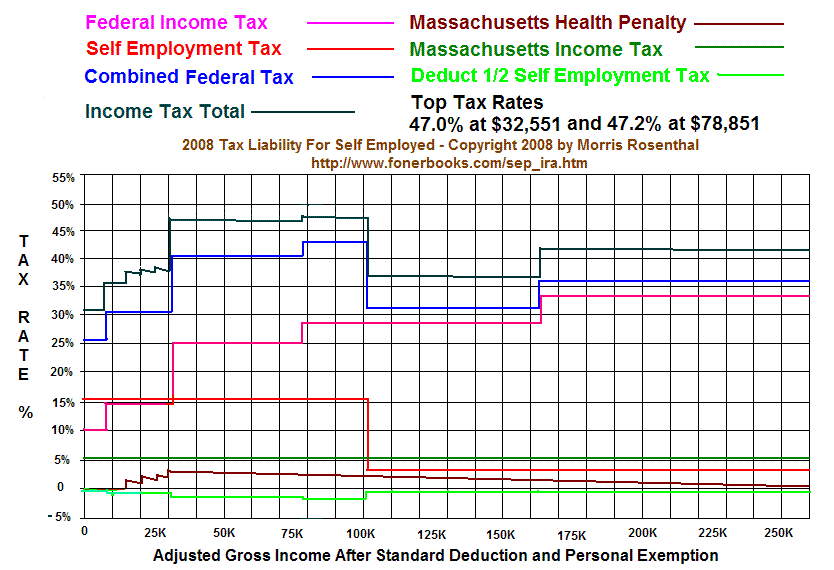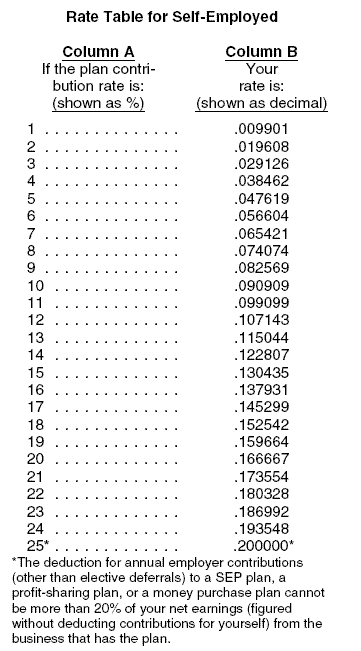
Self Employed SEP IRA Tax Deduction
Copyright 2010 by Morris Rosenthal - - contact info
- Filing Schedule C
- Car Expenses
- Freelancer and Contractor Payments
- Section 179 Depreciation and Form 4562
- Employee Benefits and Pension Costs
- Professional Services, Business Taxes and Fees
- Deducting Meals and Entertainment
- Hotel and Travel Expenses
- Inventory and Cost of Goods Sold
- Sole Proprietor Statistics
- Self Employment Taxes
- Retirement Savings for Self Employed
Copyright 2010 by Morris Rosenthal
All Rights Reserved
SEP Contribution Limit And Maximum Benefit Depends on Taxable Income
Warning: These pages are not intended as professional advice. They are presented "as is", reader beware!
The whole point of official retirement savings plans is tax deferral. There's nothing magical about what happens to the money in Traditional IRAs (Individual Retirement Account) or SEP (Simplified Employee Pension) IRAs, there's no special retirement insurance (though the money may be protected in some bankruptcy cases), it's simply tax deferred. If you need the money before retirement, with a few narrow exceptions, you pay a 10% penalty on the money you take out, plus you pay regular income tax on that money in the year you take the early distribution. For self employed sole proprietors, the only retirement investment you can make that qualifies as a business tax deduction is to invest in building your business for the ongoing income or eventual sale. Otherwise, if you work for yourself, your retirement savings cannot be a business expense, they are only useful as a deduction against your Federal income tax. In the higher tax brackets, especially 25% or more, a tax deduction for your IRA or SEP contribution is far more meaningful than if you are in the lower tax brackets. For example, a self employed person in the 10% tax bracket who contributes $1,000 to a tax deferred retirement savings account saves all of $100 on his tax bill. A self employed person in the 25% bracket who contributes $1,000 to an IRA or SEP saves $250 on his tax bill, and an entrepreneur in the 35% tax bracket who contributes $1,000 to a retirement account saves $350 in taxes. Another way to look at it is, it costs the low earning self employed person $900 to put $1,000 aside for retirement, while it only costs the high income sole proprietor $650 to put $1,000 aside for retirement.
The traditional IRA deduction is a progressive tax deduction, if I can use that expression, because the full deduction amount is available to the lowest income individuals (who can scrape up the money to save it) and is phased out for higher income individuals. It's not a progressive tax savings, because it's only worth 10% to low income savers vs 35% to high income savers. For the 2010 tax year, the maximum contribution limit is $5000 (or $6000 if you're over 50 years old), provided you earned that much taxable income. Individuals with an adjusted gross income between $53,000 and $63,000 see their maximum tax deferred contribution phased out to $0, and a married couple watches the contribution wind down if they earn between $85,000 and $105,000. Note that above the maximums, $63,000 for single and $105,000 for married, no tax deferred contribution to a traditional IRA is allowed, not one penny. Fortunately for self employed people who are actually successful, you can set up a retirement plan other than a traditional IRA. The only type I'm going to talk about here is the SEP IRA, because it's the simplest plan that requires no special overhead or outside administration. For the self employed individual, there's a special formula for determining the maximum amount your contribution can be, but it amounts to 20% of Schedule C income, up to $46,000.

In addition to a regular IRA, there are other tax-exempt savings plans available to self-employed individuals, and starting in 2002, this included 401K's. I have a Self Employed Pension Plan (SEP) which allows me to contribute nearly 20% of my income, sheltering that money from Federal income tax (as with the IRA, it doesn't help any with self-employment tax or state tax around here). It follows a crazy formula I always forget that adjust for the contribution you will be making, which is why I put it in my computer business book so I'd know where to find it. The SEP contribution limit is computed from three factors:
A = Net earnings from Schedule C
B = Deduction for self employment (one half of amount paid)
C = The Factor = (contribution percentage) / (1 + contribution percentage)
At a contribution percentage of 15%
C = 0.15/1.15 = 0.1304
Contribution = (A-B)*C
The contribution percentage for an SEP is limited to 25% for self employed, and that's before you work through the formula above, reducing it for one half of self employment tax, etc. The maximum contribution limit for an SEP, regardless of how much you earn, is $46,000.
At the maximum contribution percentage of 25%
C = 0.25/1.25 = 0.2 or 20%
Contribution = (A-B)*C
Maximum Contribution = (Schedule C Net Earnings - One Half Self Employment Tax ) * .20] but no higher than $46,000
You don't really need to use the formula above for a plan with a whole plan percentage contributions because the IRS provides a table that does the rate calculation. However, you'll have to go through the calculation for "The Factor" if your plan contribution percentage isn't a whole number.

Where you can't forget to reduce your total net earnings (profit) by one half the self employment tax before multiplying by 16.66% for the maximum contribution. Rather than multiplying by the percentage, you can just divide by 6, comes out the same way at the SEP limit, but I always leave a little extra room so if I've made a clerical error and my tax bill is a few dollar higher, it doesn't push my SEP contribution over the limit and trigger some penalty phase and endless paperwork. The IRS paperwork for setting up a SEP is here.
One common alternative to the traditional IRA is the Roth IRA, in which you pay income tax in the year you commit the money to the Roth IRA, but you don't pay income tax on the distributions once you are retired. While this may have worked properly when Roth accounts were first introduced, there's every reason to believe that the government will rewrite the laws in the future, probably through further means testing Social Security and Medicare payments, so that the "tax free" income from the Roth will be partially offset by the means testing penalties on net income. While the same means testing will apply to distributions from a traditional or SEP IRA, at least there is a front end tax savings on putting money into those accounts. While nobody can say definitively what the future will bring, I think Roth IRAs for high income savers in the current environment are primarily useful for estate planning, since the money can be left to heirs to grow "tax free" until their retirement. And there is no minimum required withdrawl for Roths. Roth IRAs to make terrifc sense for individuals with low enough earnings to be in the 10% tax bracket, especially if the Roth contribution of $5,000 lowers their tax liability to zero. In that way, a low income self employed person can shift regular savings (if they have any) into a Roth at no cost, so it's no loss if the rules change radically. If you have the flexibility and courage not to buy into other people's plans for you, I believe the best chance a self employed person has for a decent retirement is to build their business to the point that it provides a healthy income and growth opportunities, and not to sell out until senility sets in. Aside from keeping you business going, I would plan for retirement without making any assumptions about Social Security income - if it's materializes, treat it as a bonus, but plan on it not being there and save accordingly in both tax deferred and taxable accounts.
This guide is in progress, and I welcome your comments, questions and suggestions
Calculating Mortgage Interest | Federal Tax Free I-Bonds | Buying Bank CDs | CPI-U and Inflation | Tax Free Munis | Buying T-Bills | Mortgage Tax Breaks | Buying TIPS